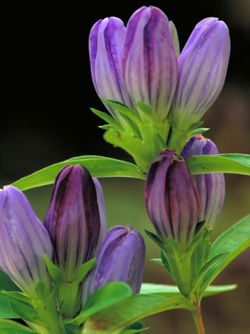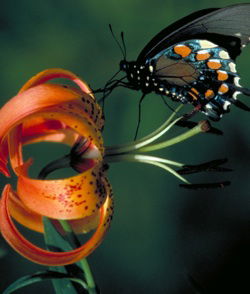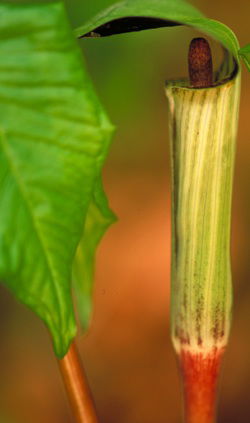
God Created Plant Pollinator Partners
Abstract
Although some plant species rely on wind or water to transfer pollen from one flower to the next, the vast majority of all plant species need the help of animals for pollination.
It is clearly stated in the bible that all kinds of plants were created at the same time.
And God said, Let the earth bring forth grass, the herb yielding seed, and the fruit tree yielding fruit after his kind, whose seed is in itself, upon the earth: and it was so. And the earth brought forth grass, and herb yielding seed after his kind, and the tree yielding fruit, whose seed was in itself, after his kind: and God saw that it was good. And the evening and the morning were the third day (Genesis 1:11-13, KJV).
God’s care for His creation is evident through the adaptability inherent within each kind. We must acknowledge that modern day taxonomic levels, like species, genus, and family, cannot simply be applied to the Biblical term “kind.” It is very interesting to note that Carolus Linnaeus, an 18th century botanist, developed a system for naming, ranking, and classifying organisms that is still in wide use today (with changes as accepted). Linneaeus’ study of biological classification (taxonomy) was founded on the basis of his Biblical belief that living things were created to multiply after kind, and that these created kinds could be rationally grouped in a hierarchical pattern reflecting themes and variations in the Creator’s mind. Thus, scientific names are provided in this article to distinguish individual animal and plant names because in Linnaeus’ own words, “The Earth's creation is the glory of God, as seen from the works of Nature by Man alone. The study of nature would reveal the Divine Order of God's creation, and it was the naturalist's task to construct a 'natural classification' that would reveal this Order in the universe.”
For land animals and birds, the created “kind” most often corresponds to the scientific rank of “family,” which includes many species. If we relate created kinds to scientific families, estimates as to the number of animals on Noah’s Ark might be as few as 2,000 or as high as 16,000 (clean animals came in by sevens) based on space restrictions. Species expanded over the land after the Flood diversified, or faded away and new variations appeared. However, the information within the kinds continued on from the original Genesis creations as species adapted and changed.
Successful fertilization that follows pollination of a flowering plant produces the growth of seeds and fruit. Although some plants rely on wind (corn, wheat, rice, oats, barley) or water (some aquatic plants) to transfer pollen from one flower to the next, the vast majority (almost 90%) of all plant species need the help of animals for pollination. Pollinators play an important role in maintaining diverse plant communities that provide food for wildlife and ensure pollination for approximately 35 percent of food crops worldwide. Farmers in the U.S. rely upon insect pollinators to produce a wide variety of fruits and vegetables including apples, almonds, berries, cherries, cucumbers, melons, squash, and sunflowers. These insect-pollinated foods, plus indirect food products (such as milk from cows that feed on pollinated alfalfa), represent 15 to 30 percent of all foods consumed in the U.S. Now that we know the importance of animal plant pollination to provide many of our staple food crops, let’s examine some plant pollinator relationships in more detail.
Beginning with the Bible, we know that flowering plants and trees were created on Day 3 and their animal pollinators were created on Day 5 (birds, nectar bats, flying insects) and Day 6 (crawling animals). God created in such a way that beneficial partnership could readily form between the members of various plant kinds and animal kinds during Creation Week to quickly produce a bountiful seed and fruit crop. Because God designed created kinds to be fully capable of adjusting and adapting (equaling variation) as new and different environments were encountered, these pollinating partnerships were re-established, perhaps in new and amazing ways, as the plant and pollinator kinds spread across the earth after the Flood (Gen 8:17).
Symbiosis is a close ecological relationship between the individuals of two (or more) different species.
Being created with the ability to adapt can produce unique symbiont pairs. Symbiosis is a close ecological relationship between the individuals of two (or more) different species. Sometimes a symbiotic relationship benefits both species, sometimes one species benefits at the other's expense, and in other cases neither species benefits.
Let’s discuss the requirement of plant pollination where both species benefit from the relationship. Ecologists term this type of symbiotic relationship as Mutualism. Each plant’s ability to adapt has led to wondrous changes in physical structure changes precisely suited to accomplish specific functions or chemical changes to attract specific insects. The great variety in color, shape, pattern, and scent we observe in flowers is a direct result of the intimate association of flowers with their pollinating partner. Let’s examine a few of these the unique relationships we find in today’s post-Flood world.
Flower Shape or Structure

Bottle Gentian
Photo Credit: Dr. Thomas Barnes/USFWS
http://www.fws.gov/digitalmedia/FullRes/natdiglib/B3IMG0044.jpg
Bottle Gentian Gentiana andrewsii
The Bottle Gentian is woodland flower found west as far as Manitoba to Vermont in the east, southward to Virginia and Missouri, and in the northern Plains States. Mature flowers look like large buds and the petals remain closed. Although these flowers produce a rich source of pollen and nectar, most insect pollinators are not able to get inside. Bottle gentians are pollinated, almost exclusively, by large bumblebees that are strong enough to force the petals open and crawl inside. Flower nectar is produced by glands in the flowers called nectaries. Bees suck nectar from flowers with their long tube-shaped tongues. In the process, the bees become covered with pollen, which is transferred from flower to flower as it makes its rounds. A bee will visit only flowers of the same species on each round of gathering. This ensures that the pollen it is transporting pollinates the correct species. The bees benefit by having exclusive access to a bountiful nectar supply, and the plants benefit by attracting loyal pollinators that improve the chances for cross pollination.

Turk's cap lily
Photo Credit: Dr. Thomas Barnes/USFWS
http://www.fws.gov/digitalmedia/FullRes/natdiglib/B4IMG0052.jpg
Turk's cap lily
Turk's cap lily (Lilium superbum) plants have pendant flowers that hang down, providing no landing pad for heavy beetle or bee pollinators. The unique design however, allows pollination by butterflies. The light-weighted butterfly can grasp the large anthers from below and obtain nectar. This lily is pollinated primarily by swallowtail butterflies.
Flower Scent
Carrion or Foul Smelling Flowers
Carrion flowers and foul smelling flowers entice flesh and fecal-loving insects to their foul-smelling blooms by their colors and putrid scents that smell and look like rotten flesh. Plant families vary, but this group contains some of the largest and most bizarre flowers blossoms on earth. Some species may trap the pollinating insects temporarily with movable parts in the flower to ensure the gathering and transfer of pollen. Beetles have a highly developed sense of smell. Therefore, flowers to which beetles are attracted are often white or dull in color and have strong odors.
Pawpaw (Asimina triloba)
The pawpaw is native to the temperate woodlands of the eastern U.S. Pawpaw flowers are perfect, in that they have both male and female reproduction parts, but they are not self-pollinating. The meat-colored petals and fetid aroma of the pawpaw attract carrion flies (blow flies, bluebottles, greenbottles or cluster flies) and beetles (Family Nitidulidae). Flies will eat nectar and plant sap, along with blood, other insects, and decaying matter.
Dung beetles and skunk cabbage

Skunk Cabbage
Photo Credit: Wikimedia commons
http://upload.wikimedia.org/wikipedia/commons/8/88/%E3%82%B6%E3%82%BC%E3%83%B3%E3%82%BD%E3%82%A6P7020102.JPG
Skunk Cabbage (Symplocarpus foetidus) is wetland wildflower found in eastern North America. The first part of this unique wildflower to emerge from below ground in the early spring is the spathe (hood) that is color combination of browns, greens, and purples. The ability of the spathe to quickly emerge in late winter is because the respiration of the plant produces heat which protects the developing flowers from freezing and dying. The spathe houses the developing spadix (spike stalk) which is covered with numerous, small, tightly-packed yellow flowers that are hermaphroditic, thus not relying on nearby plants for cross pollination. The spathe also assists in holding in the flower’s heat so as to vaporize the scent that attracts pollinating insects. An opening of the spathe allows entry and pollination by some of the earliest flying insects in the spring, including flies, honey bees, and beetles (Pelecomalium testaceum).
Fungus or Mushroom Odor Flowers
Then there are the flowers that imitate types of mushrooms (shelf fungi) that are found growing on nearby trees. A gnat who attempts to lay eggs on what it thinks is a mushroom, is guided by the flower's lip and mushroom odor to the flower stigma for pollination.
Cocoa Trees
Chocolate comes from Cocoa trees (Theobroma cacao) that grow in the tropics. This tree’s blossoms are unusually located on the trunk and lowest branches. The white flowers are small and face downward. The tiny flowers attract tiny flies, known as midges. The midges are ordinarily attracted to fungus and the cocoa flowers emit a mushroom smell. For the cocoa tree to bear fruit, first it has to be pollinated by midges (Forcipomyia species).

Jack-in-the-pulpit
Photo Credit: Dr. Thomas Barnes/University of Kentucky/USFWS
http://www.fws.gov/digitalmedia/FullRes/natdiglib/B1IMG0090.jpg
Jack-in-the-pulpit
Jack-in-the-pulpit (Arisaema triphyllum) flowers have a fungus-like smell that attracts many tiny insects, particularly fungus gnats (families Mycetophilidae and Sciaridae) and thrips (Heterothrips arisaemae). The inflorescence consists of a central spadex which holds the flowers surrounded by a tube with a green to purple spathe (hood) on top. The flowers are located inside the tube at the base of the spadex. Insects enter through the top and are drawn to the pollen at the bottom. Male plants have a small hole at the bottom of the spathe for insects to escape. Female plants do not have a bottom escape route, so an insect must find its way back to the top of the plant. If the insect is trapped and dies, it is not a case of mutalism.
Fragrant Flowers
Floral scents are derived from oils in the plant. Flowers that use scents to attract their pollinators are generally drab in appearance, white, purple to dark red-brown, and exude very strong scents that can be detected at a distances over 1/2 mile. The flower’s pollinator detects the scent and follows the concentration of the chemical to the flower.
Western Prairie Fringed Orchid
The Western Prairie Fringed Orchid (Platanthera praeclara) stands 4 feet tall in North America's remaining tallgrass prairies. The plant has up to two dozen white-fringed flowers. Pollinating insects are not attracted to the flowers during the daylight. The flowers increase their fragrance to attract roaming moths at night. The long-tongued hawkmoth (family Sphingidae) has a unique tongue for harvesting the orchid's nectar. The orchid's petals direct approaching moths to the nectar-holding spur. This orchid’s nectar spur is the longest of any North American orchid. As the moth hovers with its long tongue extended into the spur, two pollen-bearing structures brush pollen onto the eyes of the moth. Only those species of hawkmoths with suitable-length tongues and properly spaced eyes can act as pollinators. The remarkable relationship between the long-tongued hawkmoths and western prairie fringed orchid has been a successful partnership for centuries until European settlers began farming the heartland of North America. Approximately a quarter of known western prairie fringed orchid sites are now protected in preserves or managed areas.
Yucca moths
Yuccas (Yucca species) are mostly found as shrubs with rosettes of stiff, sword-shaped leaves arising at ground level. The scent of the yucca blossoms is strongest at night. An extraordinary partnership exists between the Yucca moth (Tegeticula species or Parategeticula species) and Yucca plant. They are so interdependent that one cannot live without the other. The adult yucca moth does not need to feed because it is very short lived. However, the female gathers pollen, which it holds under its chin with the help of specialized “tentacles.” Female Yucca moths can detect the smell of other female moths with her antennae and, if another one has been there already, she searches for another flower. She lays a few of her eggs in each selected ovary of the Yucca flower. Then she goes to the stigma of the flower and carefully removes some pollen from under her chin and deposits it on the stigma. Pollination allows the flower to produce a fruit and enough seeds to feed the larvae, as well as ensure the reproduction of the plant. Once the larva is fully-grown, it drops to the ground, buries itself, and makes a cocoon. Male and female Yucca moths emerge from their cocoons in the spring in synchrony with the blossoming of the species of yucca with which they are partners. They meet and mate on the yucca blossoms beginning the cycle again.

Scotch Broom
Photo Credit: MPF Newcastle, UK
http://upload.wikimedia.org/wikipedia/commons/f/f1/Cytisus_scoparius1.jpg
Scotch Broom
Scotch Broom (Cytisus species) consists of about 80 species native to Eurasia and North Africa. Many varieties are cultivated as ornamentals; several species have become naturalized, and some invasive in the United States. The showy yellow flowers are typical of the pea-family and appear on the plants in great number in May and June. Each flower must be visited by an appropriate pollinator for fertilization to take place, so the mutualistic relationship with honey bees and native bumblebees is essential. Other native North American insects seem to ignore its fragrant blossoms, preferring to visit the flowers of native species.
Internal Flower Pollination
Wasps are very important pollinators. Wasps are in the same Order, Hymenoptera, as bees and ants. However wasps are generally not covered with fuzzy hairs, which easily hold pollen, like bees. Wasps may be less efficient in pollinating flowers but still play important roles.
Fig trees
Fig trees (Ficus species) are a cornerstone species in many tropical ecosystems. Fig wasps are responsible for pollinating almost 1,000 species of figs. Figs are unusual fruits as the flowers are actually inside the immature fruit. When the female flowers inside the immature fruit are ready for pollination the fig fruit emits an enticing aroma that attracts only female wasps of the specific type for that tree. Fig wasps enter through a tiny pore to mate, lay eggs, and pollinate the tiny flowers. Eggs mature inside the future seeds that will nourish the female wasp’s progeny and she spreads pollen collected from the previous fig where she was born. Female wasps die inside the fig, but they have gained a reproduction resource from the fig fruit. Some fig trees require the services of one specific species of wasp. The Strangler Fig (Ficus aurea) is pollinated by Pegoscapus mexicanus wasp and the Shortleaf Fig (Ficus citrifolia) by Pegoscapus tonduzi wasp.
External Nectaries
Ants (Family Formicidae) are highly social insects and are often associated in one way or another with plants. Ants sometimes form mutualistic relationships with plants, which may benefit from ant predation on plant-eaters or seed dispersal by ants. Ants also have smooth bodies that pollen can not adhere to, and by walking they do not cover as much distance as flying pollinators. But ants are numerous, highly social and frequently return to favorite feeding sites, therefore they are frequent visitors of nectar-producing flowers.
Sometimes flowers supply nectaries outside the flowers to attract ants that ward off other insects from stealing the nectar. Many tropical plants have nectar outside of the flowers to attract ants. Many tropical plants have floral structures that make it difficult for bees and other pollinators to access internal nectar. These plants apparently have a chemical deterrent to keep the ants from entering the inside of the flower while rewarding them with nectar for protecting the outside of the flower. Ants can be effective pollinators in plant species with a low, dense flowering stature and in those growing in Mediterranean and alpine habitats where ant visitation rates can be higher than other floral visitors.
Some examples of plants that have ants as defenders and possible pollinators include Fava beans (Vicia faba) that extrafloral nectaries which release sugary nectar even when the flowers are not open. Cascade knotweed (Polygonum cascadense) is regularly cross-pollinated by the ant. Other plants pollinated by ants are: Alpine Nailwort (Paronychia pulvinata), and Small's Stonecrop (Diamorpha smallii).
Conclusion
With a mutualistic relationship, the plant expends less energy in pollen production and instead produces showy flowers, nectar, and/or odors. A flower that attracts specific pollinators on a regular basis has an advantage of wasting less pollen versus flowers that attract promiscuous pollinators. The pollinator gains an advantage of having its own private food source, thereby exerting less energy in competitions between insect species. The plant must supply a reward, nectar and pollen; an attractant, brightly colored flowers or odor; and a mechanism for pollen transfer. The plant and pollinator have adapted together under God’s original design. Some species, you will have to agree, have very unique harmonious relationships that could not have arisen randomly. The variation within each of God’s created kinds is truly astonishing.
Romans 1:20 For the invisible things of him from the creation of the world are clearly seen, being understood by the things that are made, [even] his eternal power and Godhead; so that they are without excuse:
Ecclesiastes 3:11 He hath made every [thing] beautiful in his time: also he hath set the world in their heart, so that no man can find out the work that God maketh from the beginning to the end.
“There is a wonderful harmony in the divine Providence and all its disposals, so that the events of it, when they come to be considered in their relations and tendencies, together with the seasons of them, will appear very beautiful, to the glory of God and the comfort of those that trust in him. We are to believe that God has made all beautiful. Every thing is done well, as in creation, so in providence, and we shall see it when the end comes, but till then we are incompetent judges of it” (Matthew Henry 1662-1714).
References
- Wood, Todd Charles, 2007. Two of Every Kind, Answers Magazine 2(2):32-34.
- Jones, A. J., 1973. “How many animals on the ark?” Creation Research Society Quarterly 10(2):102–108.
- Marks, Raissa, 2005. Native Pollinators, Fish and Wildlife Habitat Management Leaflet Number 34, United States Department of Agriculture, Natural Resource Conservation Service, Wildlife Habitat Management Institute.
- Ham, Ken, 2006. Could God Really Have Created Everything in Six Days?, The New Answers Book.
- Wise, Kurt, 2009. Lucy Was Buried First, Answers Magazine 2(2):66–68.
- Meyer, John R., 2000. Symbiotic relationships, Entomology For Educators, Department of Entomology NC State University, www.cals.ncsu.edu/course/ent591k/symbiosis.html.
- Celebrating Wildflowers, U.S. Forest Service, Rangeland Management, Botany Program Washington DC. www.fs.fed.us/wildflowers/.
- Pomper, Kirk W. and Layne, Desmond R., 2004. North American Pawpaw, Chronica Horticulturae, 44(3):11–15. International Society For Horticultural Science.
- Feller, Ilka, 1999. A Pattern of Sex-Biased Herbivory in Jack-in-the-Pulpit, Smithsonian Environmental Research Center, Spring 1999 Newsletter, pp. 10-12.
- For Lack of a Moth, the Orchid Is Lost, U.S. Fish And Wildlife Service, Colorado, Vol. II, No. 4, www.fws.gov/feature/orchid.html.
- Meyer, Susan E., 1974. Scotch broom, The Woody-Plant Seed Manual, USDA Forest Service, (USDA Misc. Publ. 654).
- Ants as Pollinators, National Biological Information Infrastructure (NBII), pollinators.nbii.gov/portal/community/Communities/Ecological_Topics/Pollinators/Pollinator_Species/Invertebrates/Ants/.
- Hickman, James C., 1974. Pollination by Ants: A Low-Energy System. Science 184(4143):1290–1292.

Answers in Genesis is an apologetics ministry, dedicated to helping Christians defend their faith and proclaim the good news of Jesus Christ.
- Customer Service 800.778.3390
- © 2024 Answers in Genesis

